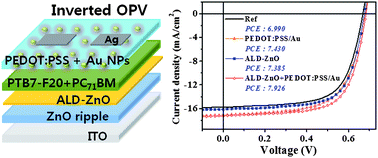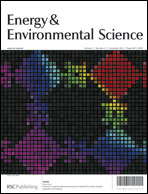Towards fabrication of high-performing organic photovoltaics: new donor-polymer, atomic layer deposited thin buffer layer and plasmonic effects†
Abstract
Using a novel polymer (polythienothiophene-co-benzodithiophenes 7 F-20) as a donor and phenyl-C71-butyric acid methyl ester as an acceptor of bulk heterojunction, inverted organic photovoltaics (OPVs) were fabricated. Wet-chemically prepared ZnO and poly(3,4-ethylenedioxythiophene):poly(styrenesulfonate) (PEDOT:PSS) were used as buffer layers. Particularly, for PEDOT:PSS deposition, no annealing step was employed. This inverted OPV showed a power conversion efficiency (PCE) of ∼7.0%, which is comparable to the hitherto reported highest efficiency of the inverted OPV with vacuum-deposited MoO3 as hole-collecting buffer layers without plasmonic enhancements. Incorporation of Au nanoparticles into PEDOT:PSS was performed for plasmonic enhancement of the electromagnetic field, whereas ZnO thin layers were deposited on ZnO using atomic layer deposition for quenching electron–hole recombination at surface defects of ZnO ripples. These additional treatments could be used for improving the performance of OPV, which ultimately resulted in a PCE of 7.9%.


 Please wait while we load your content...
Please wait while we load your content...